Click on images to enlarge

infestation (Photo: Sheldon Navie)

infestation (Photo: Land Protection, QDNRW)
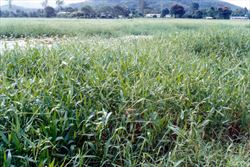
habit in flower (Photo: Land Protection, QDNRW)
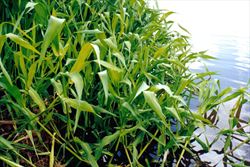
habit (Photo: Land Protection, QDNRW)
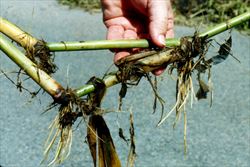
stems with roots (Photo: Land Protection, QDNRW)

stems and large leaves (Photo: Land Protection, QDNRW)

stem-clasping bases of leaf blades (Photo: Land Protection, QDNRW)

close-up of young leaves (Photo: Sheldon Navie)
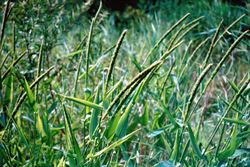
seed-heads (Photo: Land Protection, QDNRW)
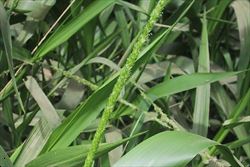
young seed-head in flower (Photo: Chris Gardiner)

seedlings (Photo: Land Protection, QDNRW)

close-up of adventitious roots at the stem joints (Photo: Sheldon Navie)
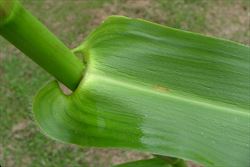
close-up of base of leaf blade (Photo: Sheldon Navie)

close-up of leaf underside (Photo: Sheldon Navie)
Scientific Name
Hymenachne amplexicaulis (Rudge) Nees
Synonyms
Agrostis monostachya Poir.Hymenachne myosurus (Rich.) NeesPanicum amplexicaule RudgePanicum amplexicaule Rudge var. deflexa DöllPanicum amplexicaule Rudge var. erecta DöllPanicum hymenachne Desv.
Family
Gramineae (South Australia)Poaceae (Queensland, New South Wales, the ACT, Victoria, Tasmania, Western Australia and the Northern Territory)
Common Names
hymenachne, olive, olive hymenachne, trompetilla, water stargrass, West Indian grass, West Indian marsh grass
Origin
Native to the Mexico, Central America, the Caribbean and tropical South America.
Cultivation
Hymenachne (Hymenachne amplexicaulis) has been cultivated in ponded pastures in northern Australia. The cultivar that has been widely grown in Australia is known as olive hymenachne ( Hymenachne amplexicaulis 'Olive').
Naturalised Distribution
This species is relatively widespread but has a somewhat scattered distribution at present. It is spreading throughout the tropical wetlands of northern Australia and is most common in the coastal districts of northern Queensland and the Northern Territory. It has also been recorded in central and south-eastern Queensland.
Also naturalised in tropical Asia and in south-eastern USA (i.e. Florida).
Habitat
This species thrives in wetter tropical and sub-tropical environments. It is a weed of swamps, wetlands, seasonally flooded areas, waterways, riverbanks and other water bodies. It is also quite common in sugar-growing areas, where it is occasionally known to invade plantations.
Habit
A large long-lived (i.e. perennial) grass that is either upright (i.e. erect) or semi-upright (i.e. ascending) from a creeping (i.e. prostrate) base, or floating on shallow water. It commonly grows 1 to 2.5 m tall, but can occasionally reach up to 3.5 m in height.
Distinguishing Features
- a large spreading grass with thick pithy stems.
- these stems are often trailing or creeping (sometimes floating on water) and regularly produce roots at their joints.
- its leaves have large, relatively broad, stem-clasping leaf blades (10-45 cm long and 2-6 cm wide).
- its elongated seed-heads are spike-like in appearance (10-50 cm long and 0.8-2 cm wide).
- they contain numerous individual flower spikelets that are 3-4 mm long.
Stems and Leaves
Its aboveground stems are relatively robust (i.e. up to 12 mm or more thick) and are often trailing or creeping in nature (i.e. they are often stoloniferous). The bases of the stems regularly produce roots (i.e. adventitious roots) at their joints (i.e. nodes). This species sometimes also produces short underground stems (i.e. rhizomes). The upright (i.e. erect or ascending) flowering stems (i.e. culms) are hairless (i.e. glabrous) and filled with a lightweight, white pith which aids in floatation.
The leaves consist of a hairless (i.e. glabrous) or hairy (i.e. pubescent) leaf sheath, which partially encloses the stem, and a leaf blade. The relatively large, elongated (i.e. lanceolate), leaf blades (10-45 cm long and 2-6 cm wide) have broad bases, that are conspicuously clasped around the stem, and pointed tips (i.e. acute apices). They are mostly hairless (i.e. glabrous), but often have hairy (i.e. pubescent) margins near their bases. Where the leaf blade meets the leaf sheath there is a small membranous flap (i.e. membranous ligule) 1-2.5 mm long.
Flowers and Fruit
The elongated seed-head (10-50 cm long and 8-20 mm wide) is dense and spike-like in appearance (i.e. a spiciform panicle). It is actually made up of numerous short branches that are held closely to the main flowering stalk (i.e. rachis). These seed-heads contain large numbers small elongated (i.e. lanceolate) flower spikelets (3-5.5 mm long). Each of these flower spikelets consists of two bracts (i.e. glumes) and two tiny flowers (i.e. florets), only one of which produces a seed. Flowering occurs from late spring through to early autumn, but is most common during early autumn.
The flower spikelets break off and fall from the seed-head entire when they are mature. The small 'seed' (i.e. caryopsis or grain) is oval (i.e. ellipsoid) in shape (1-2 mm long and 0.6 mm wide) and enclosed in several floral bracts (i.e. two glumes, a palea and a lemma).
Reproduction and Dispersal
This plant reproduces by seed and also vegetatively via stem fragments. The seeds are dispersed by birds, in floodwaters, in mud and in contaminated agricultural produce. Stem fragments are most commonly spread in floodwaters, but in the past they were also been deliberately introduced into new regions as a ponded pasture grass.
Environmental Impact
Hymenachne (Hymenachne amplexicaulis) is a Weed of National Significance and is regarded as one of the worst weeds in Australia because of its invasiveness, potential for spread, economic and environmental impacts. It has escaped from cultivation as a ponded pasture grass in recent years and now seriously threatens the wetlands of northern Australia.
Hymenachne (Hymenachne amplexicaulis) primarily invades permanent water bodies and seasonally inundated wetlands. The environmental threats posed to wetlands are severe, as it forms dense stands that reduce plant diversity and available habitat for native animals. In the Northern Territory, infestations have been found in important conservation areas including the Mary River and Kakadu National Parks, and at Murganella on the Cobourg Peninsula.
Other Impacts
Hymenachne (Hymenachne amplexicaulis) also blocks waterways, potentially causing flooding and threatening drinking water, and blocks drainage and irrigation channels in cropping areas. It has the potential to cause severe impacts on the sugar cane industry, by reducing the quality of crops and infesting irrigation channels. In one reported case, an infestation in a cane crop caused a 50% reduction in the price of the sugar.
The potential also exists for hymenachne (Hymenachne amplexicaulis) to severely detract from the high tourism value of natural wetland systems in northern Australia (e.g. Kakadu National Park). The potential loss of natural wildlife resources (e.g. fish and waterfowl) to indigenous people is also an impact that has both environmental and economic consequences.
Legislation
This species is declared under legislation in the following states and territories:
- ACT: C4 - prohibited pest plant (a pest plant whose propagation and supply is prohibited).
- New South Wales: Class 1- a state prohibited weed. The presence of the weed on land must be notified to the local control authority and the weed must be fully and continuously suppressed and destroyed (throughout the entire state).
- Northern Territory: B - spread to be controlled (throughout all of the Territory) and, C - not to be introduced into the Territory.
- Queensland: Class 2 - landowners must take all reasonable steps to keep land free of this species (throughout the entire state). It is also illegal to sell a declared plant or its seed in this state.
- South Australia: 11+ - Class 11 is a category for those species that are 'Weeds of National Significance' but not otherwise declared in South Australia. Control of this species is not currently required in this state.
- Tasmania: D - the importation or sale of this species is prohibited and measures to reduce its population in an area, eradicate it from an area, or restrict it to a particular area may be required.
- Victoria: R - a restricted weed that cannot be sold or traded in this state.
- Western Australia: P1 - trade, sale or movement into the state prevented, and P2 - to be eradicated (throughout the entire state).
Management
For information on the management of this species see the following resources:
- the National Weeds Strategy Strategic Plan for this species, which is available online at http://www.weeds.org.au/docs/hymstrat.pdf.
- the Control Methods and Case Studies Manual for this species, which is available online at http://www.weeds.org.au/WoNS/hymenachne/.
- the Biosecurity Queensland Fact Sheet on this species, which is available online at http://www.dpi.qld.gov.au.
- the New South Wales Department of Primary Industries Weed Alert on this species, which is available online at http://www.dpi.nsw.gov.au.
Similar Species
Hymenachne (Hymenachne amplexicaulis) may be confused with the closely related native species Hymenachne acutigluma. However, these two species can be distinguished by the following differences:
- hymenachne (Hymenachne amplexicaulis) can reach up to 3.5 m in height and its leaf bases are quite broad and conspicuously clasped around the stem. Its flower spikelets are also relatively small (3-4 mm long).
- Hymenachne acutigluma only grows to about 2 m tall and its leaf blades do not clasp the stem to the same degree. Its flower spikelets are also relatively large (4.5-5.5 mm long).

